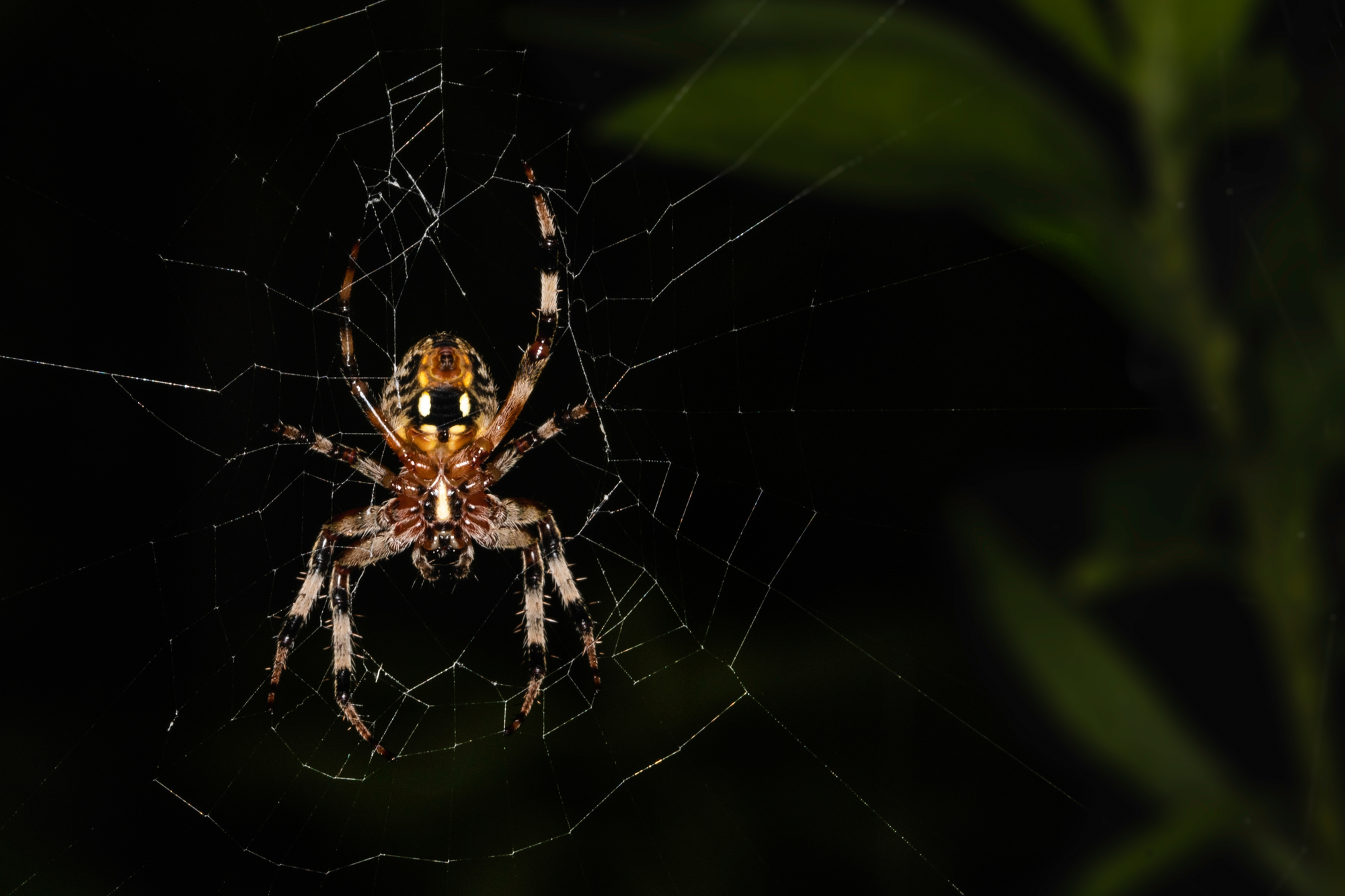
Animal Facts:
The furrow spider, also called the furrow orb spider or foliate spider, belongs to the group of orb-weaver spiders.
Their colour ranges from black, grey and red to olive, with their legs having a striped pattern. The two pairs of forward legs are long while the rear legs are shorter. Males tend to be smaller and paler in colour than females.
These spiders are most often found in damp areas, near water sources, and near or in human-made constructions all over North America as well as in Europe, Asia and Northern Africa.
In the wild, their circular web opens at the bottom and is built among grass or in low shrubbery.
Orb-weaver spiders are nocturnal. Some subspecies will tear down and consume their webs at dawn to take in moisture from the dew and the protein from the silk as well as to prevent predators like birds from seeing them. They spend the day in nearby shade and remake their web in the evening, then wait for prey to get tangled in it.
If the spider itself is not in the web when an insect flies into it, it is alerted via a trap line of silk that vibrates. The spider then rushes over, bites and paralyses the prey, then wraps it in silk for later consumption.
If something non-edible is trapped, the spider will either ignore it or remove it from the web.
Their prey consists of small insects, such as flies, moths, gnats, beetles, wasps and mosquitoes. Some of the larger orb weavers will also eat small frogs and humming birds, should they venture into the web.
Like many arachnids, the orb weavers produce a venom that’s no worse than a bee sting for humans, but which is deadly for small insects. Once they have been bitten, digestive enzymes break down the prey’s internal organs into a fluid form for the spider’s consumption. This means that larger prey needs to be stored for a longer period to give the digestive enzymes time to act.
For mating purposes, the female furrow spider creates a silk cocoon. Sitting in the cocoon, the spider then emits pheromones to lure males, which can sense them through chemoreceptors.
Males typically die after mating as the females eat them after the act.
Then, the female orb-weaver produces one or more egg sacs, each containing up to several hundred eggs, which they hide in a secluded spot – for example, on the underside of a leaf – before they die, too.
So, when the spiderlings emerge, both their parents are usually already dead.
The furrow spider has eight eyes, of which only six are visible to humans. It has a horizontal row of six eyes and an extra pair above the middle of that row. But despite this, they have poor eyesight.
They navigate their surroundings using their other senses, which include taste, smell and hearing. Because even though the spider has no ears, it can still hear thanks to the vibrations it receives via the hairs on its legs.
Finally, it’s known that spiders produce silk via glands in their bodies. But a relatively unknown fact is that one spider can produce different types of it, with orb weavers having up to seven pairs of silk glands that are used for different purposes – from wrapping their prey over building their webs to the stiffer silk that protects their eggs.
One thing that these forms of silk have in common, though, is that they’re one of the strongest natural materials on Earth. Spider silk is five times stronger than steel, yet flexible enough to be spun into a wide variety of shapes.
Some spiritual meanings:
Spiders have eight legs. Eight is the number of infinity. Thus, the spider is a symbol of the cycle of life, which says that each end comprises a new beginning.
Are you afraid to see things end?
Learn to let go if something has outlived its purpose.
The orb weaver spider continuously creates, destroys and then creates again.
With this spirit animal, you’re highly creative yourself.
You might also be inspired to write or take up some other creative venture. Your words can easily weave a story.
The spider senses vibrations when prey is trapped in its web.
Do you trust what you feel?
Or do you need to listen more closely to your emotions and intuition?
Like the spider waiting patiently for its prey, you need to be patient regarding a project or idea. Take the time to lay a strong foundation now and act when the opportunity arises.
The spider’s web connects the past to the future.
Everything you weave now brings the results you’ll encounter.
Are you weaving your dreams into reality?
Or do you need to heal some limiting beliefs and shift your focus to attract better things?
No two spider webs are the same.
Uniqueness is important to you.
The spider also encourages you to look at a problem from different angles. Follow one strand – where does it lead you? Try another option – how does this result differ?
To a spider, its web is its world.
You might need to see yourself as the centre of your world for now.
Do you need to find your authenticity before you venture out into the world?
Also, who are the people you want to build a strong network with?
The spider’s silk is both delicate and strong.
Do you allow yourself to be both fierce and gentle when the situation calls for it?
More to discover:
If you want to read up on more spirit animals or want to learn more about spiritual topics in general, pick up a copy of my two-book series “Willow and Strix” ©, available as paperback or ebook (free for kindle unlimited users) US – UK – DE and in other countries